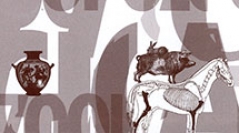

 Anthropozoologica
42 (2) - Pages 107-128
Anthropozoologica
42 (2) - Pages 107-128The seasonal movements and organization of the herds are essential features of pastoral economies. Archaeologists have sought to identify herd mobility using taxa frequencies, osteological measurements, and age profiles. Isotope analysis of faunal tooth enamel and particularly intra-tooth profiles are promising as independent lines of evidence for prehistoric mobility and seasonality. Strontium isotopes (87Sr/86Sr) can provide excellent evidence of geographic mobility. However, an understanding of physiological processes which incorporate 87Sr/86Sr into tooth enamel is lacking. Based on studies of strontium ecology, calcium metabolism, and amelogenesis, an a priori model is presented of 87Sr/86Sr ratio profiles in teeth in which animal movement and diet are independent variants. The results of the model show a close and sensitive relationship between movement and observed 87Sr/86Sr values, but also a significant effect due to differences in calcium content between components of mixed diets. This presents the possibility that 87Sr/86Sr profiles can be used in conjunction with Sr concentrations in enamel as environmental and dietary evidence.
Calcium, strontium, metabolism, isotope, transhumance.